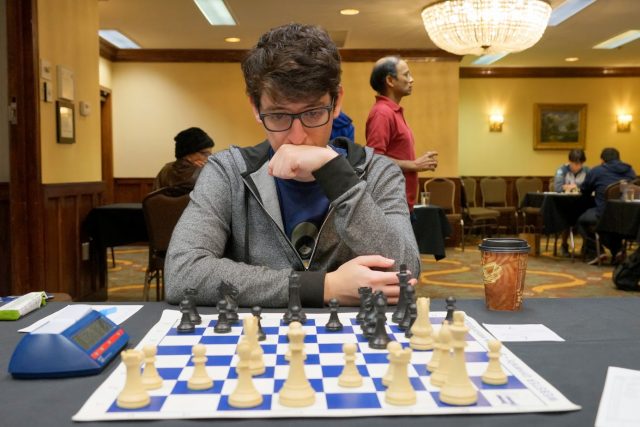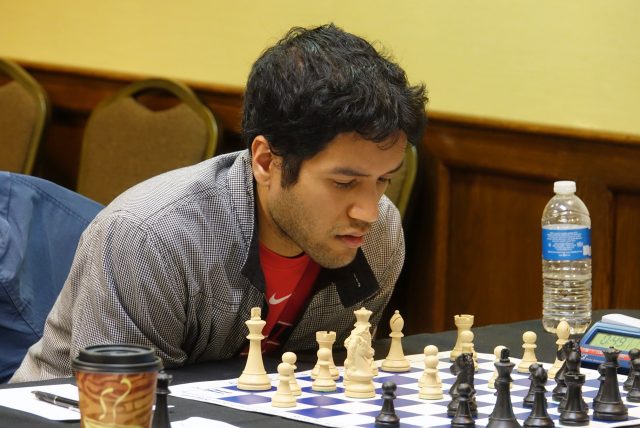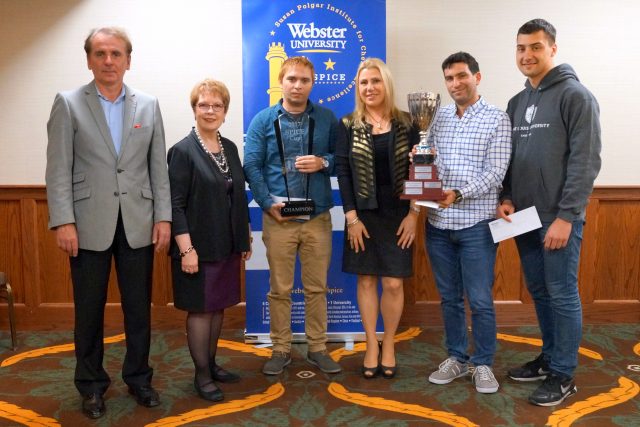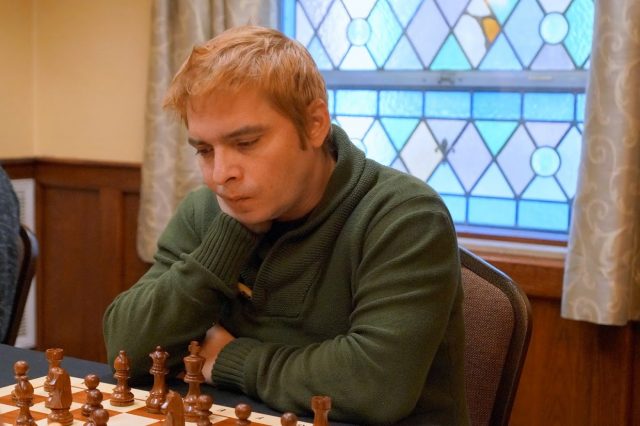Last week one of my favorite yearly events, the Spice Cup Open, concluded in Saint Louis, Missouri. This is a small but densely packed tournament open to about 50 players, organized by Susan Polgar & Paul Truong and Webster University. With both Webster University and Saint Louis University now fielding powerful rosters of Grandmasters, the Spice Cup had a total of 22 Grandmasters, many of them representing foreign federations, which makes the Spice Cup a great tournament for norm seekers. This year the event saw three players share first with 6.5/9: GM Lazaro Bruzon Batista and GM Yuniesky Quesada Perez of Cuba, as well as GM Darius Swiercz of Poland, currently playing for Saint Louis University.
I finished with a decent 5/9 and shared the top U2400 prize with my roommate for the event, IM-elect Shiyam Thavandiran. But for Shiyam this was a much more important event, with his score he managed to cross 2400 FIDE for the first time in his career and officially secure his IM title. Bravo! Full standings, games, and photos from the event can be found here. I would also encourage readers to check out GM Alex Yermolinsky’s personal recap of the event here!
Rather than go through my own event round by round, I’ll highlight some nice tactics that decided my games:
With so many strong players there were so many intriguing games, and after each round I would spend time playing through all the games of the previous round. After the tournament, I took some time to go through some of the more interesting games I could remember from the event. And like most players who play through games, I’m always interested to find the critical moment, to figure out at what point did the winning player find the decisive blow? Or if the game was not won, at one point did the advantageous side spoil their advantage? A lot of players analyze games like this, using the engine to point out the best and worst moves of the game.
But there’s one point of analysis that I’d like to share with the readers, which is truly essential for anyone who wants to feel what chess is like at high levels. When you’re using a powerful engine like Stockfish, or Komodo, or Houdini (or even Rybka, hey no judgment here ?), it can often point out a win in under a second, and flash that dazzling +2.5 and soaring evaluation. So you might see that one of the players missed a win, but here’s the thing: don’t stop there. Don’t just look at the evaluation and think “Oh, he missed Nh5, that was winning, +4! How could he miss it?!” Investigate. Input the winning move and see what the best defense is. More often than not, a strong player doesn’t simply overlook the winning move, they often see the possibility but then miss some important resource or detail in the ensuing variations. It’s important to keep this in mind as not all winning lines are created equal. In some cases, one move wins a rook on the spot and seals the deal. But in most cases, seeing the winning move requires accurately calculating multiple variations. Strong players don’t go for lines that simply “look good” without calculating deeply. One miscalculation or oversight could lead to even a very strong player rejecting a winning continuation because they weren’t able to fully “make it work”.
So here I’ve picked out some of the most interesting segments from the event, featuring some analysis of the various combinations and lines the players might have been calculating during the game. I hope you try your hand at finding the best moves in each position. Here are two wins from one of the tournament winners, GM Lazaro Bruzon Batista:
Black to play, can you see how to make use of the weaknesses in White's position?
Finally, here are two of the most interesting encounters from the event. As a brief disclaimer, please keep in mind I have no idea what the players were actually thinking at the time, I’m more or less playing detective trying to deduce what they saw or didn’t see, but nevertheless the chess is still fascinating!
Ruifeng Li vs Kostya Kavutskiy
White to Move
White has some nice compensation for the pawn in the form of active pieces,but it turns out there was a direct win, that Ruifeng spotted without much time on the clock.[pgn]
[White "Li, Ruifeng"]
[Black "Kavutskiy, Kostya"]
[Result "1-0"]
[Annotator "Kavutskiy,Kostya"]
[SetUp "1"]
[FEN "5nk1/2r2pp1/p2R3p/1p3Nq1/2p1Q3/P5PP/1P3P2/6K1 w - - 0 38"]
[PlyCount "3"]
[SourceDate "2015.04.04"]38. f4 $1 {Unbeknownst to me, Black's queen has
run short of squares!} (38. h4 {is also winning, but not as immediately:} Qc1+
39. Kg2 Qxb2 40. Rd8 $1 {With the unstoppable threat of Rxf8 and Qa8+.} f6 41.
Ne7+ Kf7 42. Qd5+ Kxe7 43. Qd6+ $18) 38... Qh5 39. Qe5 $1 {Threatening both
Qxg7 and Ne7+, so either White mates or wins Black's queen. With no way to
defend against both threats, resignation is simply mandatory.} 1-0[/pgn]
Kostya Kavutskiy vs Renato Quintillano
White to Move
White to play, find the most decisive win.[pgn][Event "2017 Spice Cup Open"]
[White "Kavutskiy, Kostya"]
[Black "Quintillano, Renato"]
[Result "1-0"]
[ECO "D45"]
[WhiteElo "2390"]
[BlackElo "2451"]
[Annotator "Kavutskiy,Kostya"]
[SetUp "1"]
[FEN "3r2k1/p4p2/1p1P2p1/4P3/2r2P1q/2p3R1/P1Q3PP/5RK1 w - - 0 31"]
[PlyCount "11"]
[EventDate "2017.??.??"]
[SourceDate "2015.04.04"]31. Rxg6+ $1 {It took me a while
to find the key idea here, but once I did the rest was simple. Black thought
for a few minutes and resigned.} (31. e6 $5 {also wins, but you'd have to see
that after} Rxd6 32. Rxg6+ Kf8 33. Qf5 $1 $18 {holds everything steady for
White.}) {After} 31... fxg6 32. Qxg6+ Kh8 (32... Kf8 33. e6 $18 {And there is
no defense to the threats of Qf7# and e7+}) {The point is} 33. g3 $1 $18 {
displacing Black's queen, after which Qf6+ will pick up the rook on d8.} Qh7 ({
In case of} 33... Rg8 34. Qxg8+ Kxg8 35. gxh4 c2 36. Rc1 $18 {White has too
many extra pawns and should win easily.}) 34. Qf6+ Qg7 35. Qxd8+ Kh7 36. d7 $18
1-0[/pgn]
Justus Williams vs. Lazaro Bruzon Batista
Black to Move
[pgn][Event "SPICE Cup 2017"]
[Site "St. Louis"]
[Date "2017.10.21"]
[Round "1"]
[White "Williams, Justus"]
[Black "Bruzon Batista, Lazaro"]
[Result "0-1"]
[ECO "A64"]
[WhiteElo "2371"]
[BlackElo "2660"]
[Annotator "Kostya"]
[SetUp "1"]
[FEN "1r4k1/4qpbp/1r1p2p1/2pPn3/5B2/RnN1P1PP/1P3P2/1R1Q1BK1 b - - 0 30"]
[PlyCount "71"]
[EventDate "2017.??.??"]30... Nd2 $1 {The start of a neat little skirmish.} 31.
Rba1 ({Of course, the knight is taboo:} 31. Qxd2 $4 Nf3+ $19) 31... Nef3+ $1 {
It's typically inadviseable to jump deep into enemy territory with your
knights *unless* there are dynamics to back you up, which in this case Bruzon
surely saw in advance:} 32. Kh1 g5 $1 {The point, White's bishop is trapped.}
33. Bg2 gxf4 34. exf4 Nb3 35. Ra7 Qe8 36. Qxf3 Nxa1 37. Rxa1 Rxb2 $19 {White
has won some material back and is only down an exchange for a pawn, but
Black's rooks are powerful and perfectly coordinated, meaning objectively
White is lost. Of course, without a second time control the players were
likely running low on time at this point, if not earlier, and the rest of the
game seems like it was played "on increment", meaning both players using not
more than 30 seconds per move. If you're curious, you can play through the
game with an engine on, but I'd suggest just clicking through and enjoying the
action.} 38. Ne4 Rb1+ 39. Rxb1 Rxb1+ 40. Kh2 Qe7 41. Qa3 Rb4 42. Qa8+ Bf8 43.
Ng5 h6 44. Nf3 Rb2 45. Qc8 Rxf2 46. Qg4+ Kh8 47. Nh4 Qe8 48. Kg1 Ra2 49. Qf5
Bg7 50. Be4 Qg8 51. g4 c4 52. g5 Ra8 53. Kf2 Bd4+ 54. Kf3 c3 55. g6 Ra2 56. Qh5
Qg7 57. Qf5 Qg8 58. Qxf7 Bg7 59. Qc7 c2 60. Nf5 Ra3+ 61. Kg4 Rc3 62. Qxd6 c1=Q
63. Nxg7 Qg1+ 64. Kf5 Rc8 65. Nh5 Rf8+ 0-1[/pgn]
Francesco Rambaldi vs. Lazaro Bruzon Batista
Black to move
Can you find (and calculate!) the best move?[pgn][Event "SPICE Cup 2017"]
[Site "St. Louis"]
[Date "2017.10.25"]
[Round "7"]
[White "Rambaldi, Francesco"]
[Black "Bruzon Batista, Lazaro"]
[Result "0-1"]
[ECO "C54"]
[WhiteElo "2574"]
[BlackElo "2660"]
[Annotator "Kostya"]
[SetUp "1"]
[FEN "5rrk/1p5p/p3b3/P2pP1p1/1p1B1n1q/1B3R1P/3Q1PP1/4R1K1 b - - 0 30"]
[PlyCount "9"]
[EventDate "2017.??.??"]30...Nxg2 $1 {This kind of thematic sacrifice is not hard to find for a player of
Bruzon's level. White's entire kingside collapses.} (30... Nxh3+ $2 {would
backfire after} 31. Rxh3 Bxh3 32. e6+ $18) 31. Bxd5 {Accepting the knight in
any way leads to a forced mate:} (31. Kxg2 Rxf3 32. Kxf3 Qxh3+ 33. Ke2 Bg4+ 34.
f3 Qxf3#) (31. Rxf8 Rxf8 32. Kxg2 Bxh3+ 33. Kh2 Bg4+ 34. Kg1 Bf3 $19) 31...
Nxe1 32. Rf6 {White plays for a chance to unleash his dark-squared bishop
against Black's king, but Bruzon is accurate until the end here:} g4 $1 {
Opening lines against White's king.} 33. hxg4 Bxd5 34. Kf1 Bc4+ {And White
resigned in view of inevitable mate.} 0-1[/pgn]
[pgn]
[Event "SPICE Cup 2017"]
[Site "St. Louis"]
[Date "2017.10.25"]
[Round "7"]
[White "Swiercz, Dariusz"]
[Black "Cori, Jorge"]
[Result "1-0"]
[ECO "E11"]
[WhiteElo "2639"]
[BlackElo "2657"]
[Annotator "Kostya"]
[PlyCount "71"]
[EventDate "2017.??.??"]
1. d4 Nf6 2. c4 e6 3. g3 Bb4+ 4. Bd2 Bxd2+ 5. Qxd2 d5 6. Bg2 O-O 7. Nf3 b6 8.
cxd5 exd5 9. O-O Bb7 10. b4 Ne4 11. Qb2 c6 12. Nbd2 Nd6 13. a4 Qe7 14. e3 Nd7
15. Rfc1 Rfe8 16. a5 Rab8 17. a6 Ba8 18. Qa3 Nb5 19. Qa4 Nc7 20. Bh3 b5 21. Qc2
Nb6 22. Qc5 Na4 $5 {Up until this point White has achieved a strategically
dominant position, as the bishop on a8 is buried thanks to White's strong pawn
on a6. Realizing how bad the situation is, Cori starts taking risks-- Black's
last move, Na4, is a big provocation. White can either trade queens and risk
losing the a6-pawn, or grab on a7 and risk getting the queen trapped. Can you
figure out the evaluation of each? SOLUTION:} 23. Qxa7 $1 {A bold decision, as
at first glance it's not clear how White gets the queen out of a7 without
giving back material. Swiercz must have calculated accurately that Black won't
be able to win the queen without giving up a lot of material. So how does
White actually excavate the queen? The key is to resuce the queen through the
c6-square: White wants Ne5 & Rxc6, winning.} (23. Qxe7 {would secure White a
smaller edge, after} Rxe7 24. Ne5 Nxa6 25. Nd3 $16 {White has more than enough
compensaiton for the pawn, as the second knight will head to a5 and White will
eventually win the c6-pawn.}) 23... f6 $5 {Stopping Ne5 but giving White time
to find another escape plan for the queen.} ({The immediate} 23... Qd8 24. Ne5
Re7 {would be quite strong except for} 25. Nd7 $1 {The knight cannot be taken
as Black's rook on b8 is also hanging.} Rc8 26. Nb6 Ne6 ({Simpler is} 26... Rb8
27. Nxa4 bxa4 28. Qc5 Nxa6 29. Qa5 $18 {and Black's position is not holdable.})
27. Qxe7 Qxe7 28. Nxc8 $18 {White has won two rooks for the queen and has a
winning position.}) ({Black can also go for the immediate} 23... Nxa6 24. Qxa6
Bb7 25. Rxa4 (25. Qa7 Ra8 26. Rxa4 bxa4 27. Qc5 Qxc5 28. dxc5 $18) 25... Bxa6
26. Rxa6 Qxb4 27. Raxc6 $18 {with a similar endgame that occurs in the game;
White's three pieces easily outplay the queen.}) 24. Nb3 $1 Nxa6 {With the
knight on b3, Cori elects to give up three minors for White's queen. Perhaps a
good practical decision, as positions with material imbalance are often tricky
to play, but Swiercz's conversion looks effortless.} ({Now after} 24... Qd8 {
White is in time with} 25. Nc5 Re7 26. Nxa4 bxa4 27. Qc5 Nxa6 28. Qa5 $18 {
with a dominant position. Black's bishop and c6-pawn are critically weak.}) 25.
Qxa6 Bb7 26. Rxa4 $1 ({Now} 26. Qa7 $2 {is bad in view of} Ra8 27. Rxa4 bxa4
28. Qc5 {and the knight hangs on b3:} axb3 $19) 26... Bxa6 27. Rxa6 Qxb4 28.
Nc5 $18 {A good rule of thumb for understanding positions with material
imbalance is this: The side with the queen needs targets, whether it's weak
pawns or an exposed king, while the side with the pieces needs stability:
outposts and good piece coordination. Here, it's clear that White's position
is in near perfect harmony.} (28. Nfd2 $18 {was a bit easier, as White takes
the c6-pawn next move.}) 28... Qb2 29. Nd3 Qe2 30. Nfe1 b4 31. Bf1 Qg4 32.
Raxc6 {All of White's pieces are defended! The only lasting annoyance is the
pawn on b3 -- it must still be rounded up.} b3 33. Rb1 Rec8 34. Rxc8+ Qxc8 35.
Nc5 Qc6 36. Ned3 {White will pick up the pawn on b3 on the next move and
Black's counterplay will run out. Next White will play Bg2, Nf4, and take the
d5-pawn. I'm not sure whether the game ended here but in any case, Black's
position is lost.} 1-0
[/pgn]
[pgn]
[Event "SPICE Cup 2017"]
[Site "St. Louis"]
[Date "2017.10.26"]
[Round "9"]
[White "Sevian, Samuel"]
[Black "Azarov, Sergei"]
[Result "*"]
[ECO "C78"]
[WhiteElo "2615"]
[BlackElo "2556"]
[Annotator "Kostya"]
[SetUp "1"]
[FEN "2r2rk1/bp3p1p/p2P1qp1/3b4/5p2/Q4N1P/PPB2PP1/3RR1K1 w - - 0 25"]
[PlyCount "19"]
[EventDate "2017.??.??"]
{This position was reached on move 24, with Sevian putting pressure and
looking to maximize his winning chances. It turned out in this moment White
had a superhuman win. How far can you calculate ahead? SOLUTION:} 25. d7 $1 {
This move is not hard to see, but the series of moves White needs to find to
make the tactics work would not be easy for a player of any level.} ({The
actual game continued} 25. Ba4 {and was drawn with accurate defense from
Azarov:} Bc5 26. b4 Bxf3 27. Qxf3 Bxd6 28. Qxb7 f3 29. Qxf3 Qxf3 30. gxf3 Bxb4)
25... Rxc2 26. Re8 $1 {With Black's bishop on d5 hanging this is already not
an easy move to see! But the variation continues...} (26. Rxd5 {leads to a
safe edge for White after} Bxf2+ 27. Kf1 $1 Bxe1 28. Nxe1 {and White would
need to see the threat of Qxf8+ followed by d8, as well as} Rxb2 29. d8=Q Rxd8
30. Rxd8+ Qxd8 31. Qxb2 $14 {in both cases leading to an endgame with a knight
for three pawns, with decent winning chances.}) 26... Bc5 27. Qd3 $1 {Hitting
multiple of Black's pieces. Now if you turn on the engine in this position
it'll say +4 after any move, and most would turn the engine off thinking that
White is easily winning. But how easy is it? Let's see, after all Black has}
Bxf3 {which keeps an extra piece on the board.} 28. Qxf3 {So not only would
Sevian have had to calculate to this position, he would also need to see that
White's d7-pawn is ready to promote and that Black cannot stop it.} Bxf2+ (
28... Rxf2 {quickly falls short:} 29. Rxf8+ Kxf8 30. d8=Q+ Qxd8 31. Rxd8+ Ke7
32. Qd5 $18) 29. Kh2 $3 {Not the only win, but an incredibly precise move when
compared to Kh1. So what's the difference?} (29. Kh1 {would not work for the
following reason:} Bb6 30. Qa3 {White's main idea, targetting the rook on f8.}
Rc5 31. d8=Q Bxd8 {and now if} 32. Rdxd8 $2 {which wins in the main line,
Black has a way out -} Qxd8 33. Rxd8 Rc1+ $1 {This check and only this check
is the difference. With the king on h2, Black would not have this resource and
end up down a rook.} 34. Kh2 Rxd8 $19) ({Stockfish points out that} 29. Qxf2 {
is winning, but let's see the full line:} Rxf2 30. d8=Q Rxg2+ 31. Kf1 $1 (31.
Kxg2 $2 Qc6+ $19 {and Black wins.}) 31... Qxd8 32. Rdxd8 {and White wins a
rook!} Rxb2 33. Rxf8+ Kg7 $18 {and White should win the endgame, but again,
seeing all this, from before your hand reaches to play 25.d7, not so easy!})
29... Bb6 30. Qa3 $1 {The final idea White would need to spot to make this
whole combination work.} Rc5 31. d8=Q Bxd8 32. Rdxd8 Qxd8 33. Rxd8 Rxd8 34.
Qxc5 $18 {Finally we can end the variation here, White wins!} *
[/pgn]
The 2018 Spice Cup has already been announced, with tentative dates set for Oct 21-26, 2018. I’d like to thank Susan Polgar, Paul Truong, chief arbiters Glenn Panner and Frank Niro, as well as the rest of Webster’s team and staff for again putting on an awesome tournament!
Kostya Kavutskiy is a professional chess player, coach, and author currently residing in Mountain View, CA. His first book, Modernized: The Open Sicilian was published in February 2015. For more of Kostya, check out his official Twitter and Facebook.Categories
Archives
- December 2025 (24)
- November 2025 (29)
- October 2025 (39)
- September 2025 (27)
- August 2025 (29)
- July 2025 (43)
- June 2025 (25)
- May 2025 (24)
- April 2025 (29)
- March 2025 (29)
- February 2025 (20)
- January 2025 (24)
- December 2024 (34)
- November 2024 (18)
- October 2024 (35)
- September 2024 (23)
- August 2024 (27)
- July 2024 (44)
- June 2024 (27)
- May 2024 (31)
- April 2024 (51)
- March 2024 (34)
- February 2024 (25)
- January 2024 (26)
- December 2023 (29)
- November 2023 (26)
- October 2023 (37)
- September 2023 (27)
- August 2023 (37)
- July 2023 (47)
- June 2023 (33)
- May 2023 (37)
- April 2023 (45)
- March 2023 (37)
- February 2023 (28)
- January 2023 (31)
- December 2022 (23)
- November 2022 (32)
- October 2022 (31)
- September 2022 (19)
- August 2022 (39)
- July 2022 (32)
- June 2022 (35)
- May 2022 (21)
- April 2022 (31)
- March 2022 (33)
- February 2022 (21)
- January 2022 (27)
- December 2021 (36)
- November 2021 (34)
- October 2021 (25)
- September 2021 (25)
- August 2021 (41)
- July 2021 (36)
- June 2021 (29)
- May 2021 (29)
- April 2021 (31)
- March 2021 (33)
- February 2021 (28)
- January 2021 (29)
- December 2020 (38)
- November 2020 (40)
- October 2020 (41)
- September 2020 (35)
- August 2020 (38)
- July 2020 (36)
- June 2020 (46)
- May 2020 (42)
- April 2020 (37)
- March 2020 (60)
- February 2020 (38)
- January 2020 (45)
- December 2019 (34)
- November 2019 (35)
- October 2019 (42)
- September 2019 (45)
- August 2019 (56)
- July 2019 (44)
- June 2019 (35)
- May 2019 (40)
- April 2019 (48)
- March 2019 (61)
- February 2019 (39)
- January 2019 (30)
- December 2018 (29)
- November 2018 (51)
- October 2018 (45)
- September 2018 (29)
- August 2018 (49)
- July 2018 (35)
- June 2018 (31)
- May 2018 (39)
- April 2018 (31)
- March 2018 (26)
- February 2018 (33)
- January 2018 (30)
- December 2017 (26)
- November 2017 (24)
- October 2017 (30)
- September 2017 (30)
- August 2017 (31)
- July 2017 (28)
- June 2017 (32)
- May 2017 (26)
- April 2017 (37)
- March 2017 (28)
- February 2017 (30)
- January 2017 (27)
- December 2016 (29)
- November 2016 (24)
- October 2016 (32)
- September 2016 (31)
- August 2016 (27)
- July 2016 (24)
- June 2016 (26)
- May 2016 (19)
- April 2016 (30)
- March 2016 (36)
- February 2016 (28)
- January 2016 (32)
- December 2015 (26)
- November 2015 (23)
- October 2015 (16)
- September 2015 (28)
- August 2015 (28)
- July 2015 (6)
- June 2015 (1)
- May 2015 (2)
- April 2015 (1)
- February 2015 (3)
- January 2015 (1)
- December 2014 (1)
- July 2010 (1)
- October 1991 (1)
- August 1989 (1)
- January 1988 (1)
- December 1983 (1)











